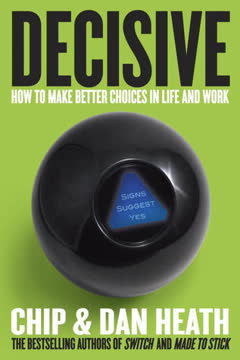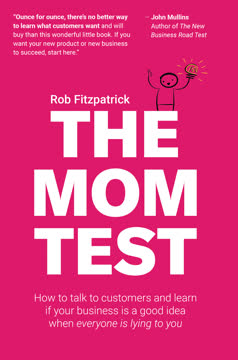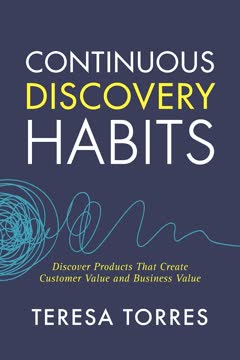Key Takeaways
1. Jobs-to-be-Done Theory: A revolutionary approach to understanding customer needs
Jobs-to-be-Done Theory provides a framework for (i) categorizing, defining, capturing, and organizing all your customer's needs, and (ii) tying customer-defined performance metrics (in the form of desired outcome statements) to the Job-to-be-Done.
Paradigm shift in innovation. Jobs-to-be-Done Theory revolutionizes how companies approach innovation by focusing on the fundamental job customers are trying to accomplish, rather than on products or demographics. This perspective allows companies to:
- Identify all customer needs systematically
- Understand the metrics customers use to measure success
- Develop solutions that address unmet needs more effectively
Stability and universality. The theory posits that jobs remain stable over time and across geographies, providing a reliable foundation for long-term innovation strategies. This stability contrasts with the ever-changing nature of products and technologies, allowing companies to:
- Create enduring value propositions
- Develop globally relevant solutions
- Innovate consistently across product cycles
2. The Jobs-to-be-Done Needs Framework: Categorizing and defining customer needs
While a job describes the overall task the customer is trying to execute, an outcome is a metric the customer uses to measure success and value while executing a job.
Comprehensive needs analysis. The Jobs-to-be-Done Needs Framework provides a structured approach to understanding and categorizing customer needs, encompassing:
- Core functional Job-to-be-Done
- Desired outcomes tied to the core functional job
- Related jobs
- Emotional and social jobs
- Consumption chain jobs
- Buyer's financial desired outcomes
Actionable insights. By breaking down customer needs into these distinct categories, companies can:
- Develop more targeted and effective solutions
- Address both functional and emotional aspects of customer needs
- Improve the entire customer experience, from purchase to disposal
3. Outcome-Driven Innovation (ODI): Putting Jobs Theory into practice
Outcome-Driven Innovation is a strategy and innovation process that enables companies to conceptualize and invent new solutions that help customers get a job done better and/or more cheaply.
Systematic innovation process. ODI transforms Jobs Theory into a practical, step-by-step methodology for innovation, including:
- Defining the customer
- Defining the Job-to-be-Done
- Uncovering customer needs
- Finding segments of opportunity
- Defining the value proposition
- Conducting competitive analysis
- Formulating innovation strategy
- Targeting hidden growth opportunities
- Formulating market strategy
- Formulating product strategy
Data-driven decision making. By following this process, companies can:
- Reduce guesswork in innovation
- Align product development with customer needs
- Increase the probability of market success
4. Uncovering customer desired outcomes: The key to successful innovation
Desired outcome statements explain precisely how customers measure success and value as they go through each step of the core functional job.
Precise need definition. Desired outcome statements are carefully constructed to capture customer needs in a measurable, actionable format. These statements:
- Follow a specific structure: direction of improvement + performance metric + object of control + contextual clarifier
- Are solution-agnostic, focusing on the underlying need rather than specific product features
- Provide a clear target for innovation efforts
Comprehensive job analysis. By mapping out the entire job process and capturing desired outcomes for each step, companies can:
- Identify previously overlooked opportunities for innovation
- Develop solutions that address the entire job, not just parts of it
- Create more holistic and effective products or services
5. Outcome-Based Segmentation: Discovering hidden market opportunities
The only way to discover segments of customers with unique sets of unmet needs is to segment the market around unmet needs.
Beyond traditional segmentation. Outcome-Based Segmentation moves past demographic or psychographic categorizations to identify groups based on their unmet needs. This approach:
- Reveals hidden segments with unique opportunities
- Provides a more accurate picture of market dynamics
- Enables more targeted and effective innovation strategies
Data-driven market analysis. The process involves:
- Capturing all customer needs as desired outcome statements
- Conducting quantitative research to prioritize needs
- Using factor and cluster analysis to identify segments with similar unmet needs
- Profiling segments to understand underlying factors causing unmet needs
6. The Jobs-to-be-Done Growth Strategy Matrix: Choosing the right innovation strategy
New products and services win in the marketplace if they help customers get a job done better (faster, more predictably, with higher output) and/or more cheaply.
Strategic innovation framework. The Growth Strategy Matrix guides companies in selecting the most appropriate innovation strategy based on market conditions:
- Differentiated strategy: Better but more expensive
- Dominant strategy: Better and cheaper
- Disruptive strategy: Worse but cheaper
- Discrete strategy: Worse and more expensive (niche situations)
- Sustaining strategy: Slightly better or cheaper
Informed strategy selection. By understanding the underserved and overserved segments in their market, companies can:
- Choose the most effective growth strategy
- Align product development with market opportunities
- Increase the likelihood of successful innovation
7. Implementing ODI: Transforming organizations for predictable innovation success
Building an outcome-driven organization is best accomplished in three phases: I: Understand your Customer's Job-to-be-Done, II. Discover Hidden Opportunities in Your Market, III. Use New Customer Insights to Drive Growth
Organizational transformation. Implementing ODI involves:
- Creating a team of internal ODI practitioners
- Establishing an Innovation Center of Excellence
- Applying Jobs Theory and ODI practices to selected markets
Phased implementation approach. The three-phase process allows companies to:
- Gain a deep understanding of customer jobs and needs
- Uncover hidden market opportunities through quantitative research
- Apply insights to drive growth through improved market and product strategies
By following this approach, organizations can systematically transform their innovation processes, leading to more predictable and successful outcomes.
Last updated:
FAQ
What's "Jobs to be Done: Theory to Practice" about?
- Focus on Innovation: The book by Anthony W. Ulwick focuses on transforming innovation from a chance-based endeavor to a predictable process using the Jobs-to-be-Done theory.
- Outcome-Driven Innovation: It introduces Outcome-Driven Innovation (ODI), a process that links customer needs to product development, ensuring that new products meet real market demands.
- Framework for Success: The book provides a framework for understanding customer needs and creating products that fulfill those needs better and/or more cheaply than competitors.
- Practical Application: It offers practical steps and case studies to help companies implement the Jobs-to-be-Done theory in their innovation processes.
Why should I read "Jobs to be Done: Theory to Practice"?
- Improve Innovation Success: The book claims an 86% success rate for innovation projects using its methods, compared to the industry average of 17%.
- Structured Approach: It provides a structured approach to understanding customer needs, which can lead to more successful product development.
- Real-World Examples: The book includes case studies from companies like Microsoft and Bosch, demonstrating the practical application of its theories.
- Comprehensive Guide: It serves as a comprehensive guide for companies looking to improve their innovation processes and achieve growth.
What are the key takeaways of "Jobs to be Done: Theory to Practice"?
- Customer-Centric Innovation: Focus on what jobs customers are trying to get done, rather than on the products themselves.
- Outcome-Driven Process: Use customer-defined metrics to guide product development and innovation strategies.
- Segmentation and Strategy: Discover underserved market segments and tailor strategies to meet their specific needs.
- Predictable Success: By understanding and addressing customer needs, companies can predictably create successful products.
What is the Jobs-to-be-Done theory?
- Core Concept: The theory posits that customers "hire" products to get specific jobs done, focusing on the desired outcomes rather than the product itself.
- Stable Over Time: Jobs are stable over time, unlike products or technologies, which change and evolve.
- Universal Application: The theory applies across different geographies and industries, as people everywhere have similar jobs they need to get done.
- Foundation for Innovation: It serves as a foundation for developing products that truly meet customer needs.
How does Outcome-Driven Innovation (ODI) work?
- Customer Metrics: ODI begins with identifying the metrics customers use to measure success in getting a job done.
- Quantitative Research: It employs unique quantitative research methods to analyze markets and uncover hidden opportunities.
- Segmentation and Strategy: The process includes segmenting markets based on unmet needs and formulating strategies to address them.
- High Success Rate: ODI claims a high success rate by aligning product development with customer-defined metrics.
What are the types of customer needs in the Jobs-to-be-Done Needs Framework?
- Core Functional Job: The primary task or goal the customer is trying to accomplish.
- Desired Outcomes: Metrics customers use to measure success in executing the core functional job.
- Related Jobs: Other functional jobs that are important to the customer while executing the core job.
- Emotional and Social Jobs: How customers want to feel or be perceived while getting the job done.
What is the Jobs-to-be-Done Growth Strategy Matrix?
- Five Strategies: The matrix outlines five growth strategies: Differentiated, Dominant, Disruptive, Discrete, and Sustaining.
- Market Positioning: It helps companies understand how to position their products based on whether they get a job done better and/or more cheaply.
- Targeting Segments: The matrix guides companies in targeting underserved or overserved market segments.
- Strategic Decision-Making: It provides a framework for making strategic decisions about product development and market entry.
What are some case studies mentioned in "Jobs to be Done: Theory to Practice"?
- Microsoft: Improved its Software Assurance offering by aligning it with customer needs, leading to increased revenue and customer satisfaction.
- Bosch: Successfully entered the North American circular saw market by addressing 14 underserved outcomes, resulting in a top-selling product.
- Kroll Ontrack: Used ODI to dominate the electronic document discovery market by focusing on customer jobs and outcomes.
- Arm & Hammer: Achieved over 30% revenue growth by realigning its market strategy around customer outcomes.
How can companies become ODI practitioners?
- Training and Tools: Companies can train internal teams to become ODI practitioners, using tools and templates provided by Strategyn.
- Project Execution: Practitioners are responsible for executing ODI projects, from defining customer needs to formulating market strategies.
- Skill Requirements: Practitioners need skills in qualitative and quantitative research, data analysis, and strategic planning.
- Organizational Transformation: By adopting ODI, companies can transform their innovation processes and achieve predictable success.
What is the role of quantitative research in ODI?
- Data Collection: Quantitative research gathers statistically valid data to inform market and product strategies.
- Segmentation Analysis: It helps discover outcome-based segments with unique unmet needs.
- Competitive Analysis: Quantitative data is used to evaluate how well competing products satisfy customer needs.
- Opportunity Identification: The research identifies which customer needs are underserved, guiding innovation efforts.
What are the best quotes from "Jobs to be Done: Theory to Practice" and what do they mean?
- "Innovation cannot be left to chance." This emphasizes the need for a structured, predictable approach to innovation.
- "People buy products and services to get a job done." Highlights the core principle of Jobs-to-be-Done theory, focusing on customer needs rather than products.
- "Outcome-Driven Innovation replaces luck with a predictable process." Stresses the reliability and effectiveness of the ODI process in achieving innovation success.
- "Knowing all the customer’s needs changes everything." Underlines the importance of understanding customer needs for successful product development.
How does "Jobs to be Done: Theory to Practice" redefine the language of innovation?
- Common Language: The book introduces a common language for innovation, centered around customer jobs and outcomes.
- Customer-Centric Terms: It redefines traditional innovation terms from a customer-centric perspective.
- Framework and Definitions: Provides clear definitions and frameworks for understanding and discussing innovation.
- Organizational Alignment: A common language helps align teams and departments around a shared understanding of customer needs and innovation goals.
Review Summary
Jobs to be Done receives mixed reviews. Some praise its practical approach to innovation, focusing on customer needs rather than solutions. However, many criticize the book for being overly self-promotional, repetitive, and lacking in concrete tools for implementation. Readers appreciate the core concept but find the execution lacking. Several reviewers note that the book feels like an advertisement for the author's consulting services. While some find value in the framework, others argue it simply repackages existing product development wisdom.
Similar Books









Download PDF
Download EPUB
.epub digital book format is ideal for reading ebooks on phones, tablets, and e-readers.





